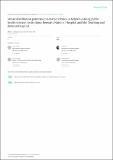Stroke distribution patterns and characteristics in Kenya’s leading public health tertiary institutions: Kenyatta National Hospital and Moi Teaching and Referral Hospital
View/
Publication Date
2018-03Type
Article, Journalviews
downloads
Metadata
Show full item recordCitation
TY - JOUR AU - Kaduka, Lydia AU - Korir, Anne AU - Oduor, Chrispine AU - Kwasa, Judith AU - Mbui, Jane AU - Wabwire, Sylvanos AU - Gakunga, Robai AU - Okerosi, Nathan AU - Opanga, Yvonne AU - Kisiangani, Isaac AU - Rotich, Mercy AU - Muniu, Erastus AU - Remick, Scot PY - 2018/05/03 SP - 68 EP - 72 T1 - Stroke distribution patterns and characteristics in Kenya’s leading public health tertiary institutions: Kenyatta National Hospital and Moi Teaching and Referral Hospital VL - 29 DO - 10.5830/CVJA-2017-046 JO - Cardiovascular Journal of Africa ER -
Abstract/
Background: Cardiovascular diseases are the second leading cause of morbidity and mortality in Kenya. However, there is limited clinic-epidemiological data on stroke to inform decision making. This study sought to establish stroke distribution patterns and characteristics in patients seeking care at Kenyatta National Hospital (KNH) and Moi Teaching and Referral Hospital (MTRH), with the ultimate aim of establishing the first national stroke registry in Kenya. Methods: This was a prospective multicentre cohort study among stroke patients. The study used a modified World Health Organisation STEP-wise approach to stroke surveillance tool in collecting data on incidence, major risk factors and mortality rate. The Cochran's Mantel-Haenszel chisquared test of conditional independence was used with p-value set at 0.05. Results: A total of 691 patients with confirmed stroke were recruited [KNH 406 (males: 40.9%; females: 59.1%); MTRH 285 (males: 44.6%; females: 55.4%) ] and followed over a 12-month period. Overall, ischaemic stroke accounted for 55.6% of the stroke cases, with women being the most affected (57.5%). Mortality rate at day 10 was 18.0% at KNH and 15.5% at MTRH, and higher in the haemorrhagic cases (20.3%). The most common vascular risk factors were hypertension at 77.3% (males: 75.7%; females: 78.5%), smoking at 16.1% (males: 26.6% females: 8.3%) and diabetes at 14.9% (males: 15.7%; females: 14.4%). Ischaemic stroke was conditionally independent of gender after adjusting for age. Conclusion: To our knowledge this is the first pilot demonstration establishing a stroke registry in sub-Saharan Africa and clearly establishes feasibility for this approach. It also has utility to both inform and potentially guide public policy and public health measures on stroke in Kenya. Important and unexpected observations included the preponderance of women affected by cerebrovascular disease and that cigarette smoking was the second most common risk factor. The latter, over time, will further impact on the clinico-epidemiological profile of cerebrovascular disease in Kenya.
Publisher
Cardiovascular Journal of AfricaCollections
- General - GEN [367]

